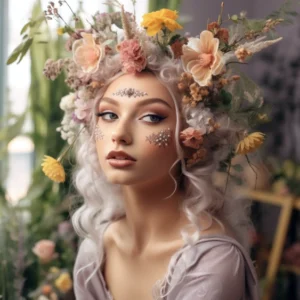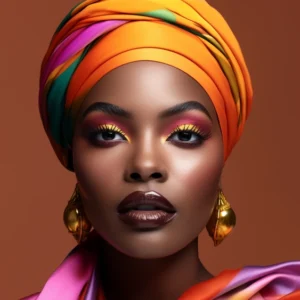Makeup, a form of self-expression and adornment, has a rich and fascinating history that spans across cultures and centuries. From ancient rituals to contemporary trends, the evolution of makeup reflects societal changes, artistic expressions, and technological advancements. This article explores the captivating journey of makeup through time, highlighting timeless techniques that have stood the test of time, now reimagined with a modern twist.
Ancient Beginnings: Rituals and Symbolism
Ancient Egypt:
The origins of makeup can be traced back to ancient civilizations, with Egypt standing out as a pioneer in cosmetic practices. Both men and women adorned themselves with elaborate eye makeup, using kohl to outline the eyes, creating an iconic almond shape. This practice had not only aesthetic but also protective qualities, believed to ward off the evil eye and protect against eye infections.
Greece and Rome:
In ancient Greece and Rome, makeup became intertwined with notions of beauty and societal status. The use of lead-based powders and chalks was prevalent among the upper classes, emphasizing a pale complexion as a symbol of wealth and sophistication. Red pigment derived from natural sources like crushed berries was applied to the lips and cheeks.
Medieval Elegance: The Renaissance and Elizabethan Eras
The Renaissance:
The Renaissance witnessed a revival of art, culture, and beauty ideals. Women sought to emulate the fair complexions seen in classical art, using lead-based Venetian ceruse to achieve a pale look. The emphasis on symmetry and balance extended to makeup application, creating a harmonious and polished appearance.
Elizabethan Era:
The Elizabethan era was marked by elaborate and theatrical makeup styles. Queen Elizabeth I set the trend with her iconic look of a pale complexion, vibrant red lips, and darkened eyebrows. Lead-based cosmetics were still prevalent, despite their known health risks. The pursuit of beauty often came at the expense of health during this period.
The Natural Beauty Movement: 18th to 19th Century
Rococo Influence:
In the 18th century, the Rococo era embraced a more natural aesthetic. Women sought a delicate and pastoral look, favoring a softer complexion. Rouge, made from natural ingredients like crushed flowers, was applied to the cheeks, while lip balm provided a subtle hint of color.
Victorian Era:
The Victorian era brought a dichotomy in makeup trends. While Queen Victoria herself eschewed heavy makeup, the use of cosmetics persisted among the upper and middle classes. Lip and cheek stains gained popularity, and the first commercial lipsticks emerged. However, societal norms often associated heavy makeup with vulgarity, leading to a nuanced relationship with cosmetics.
The Glamour of the 20th Century
Golden Age of Hollywood:
The 20th century witnessed a revolution in makeup, propelled by the influence of Hollywood glamour. Icons like Marilyn Monroe and Audrey Hepburn popularized red lipstick, winged eyeliner, and defined brows. Max Factor, a makeup artist to the stars, introduced the concept of a “makeup face” with his beauty calibrations.
The Swinging Sixties:
The 1960s embraced bold, innovative makeup trends. Influenced by the mod movement, women experimented with vibrant eyeshadows, false lashes, and geometric eyeliner. Twiggy, with her iconic doe-eyed look, became a symbol of the era’s playful and experimental approach to makeup.
Contemporary Expression: Makeup in the 21st Century
The Rise of Social Media:
The 21st century brought about a democratization of beauty through social media platforms. Makeup tutorials, beauty influencers, and online communities revolutionized how people approach and engage with cosmetics. The emphasis shifted towards self-expression, inclusivity, and embracing individual beauty.
Diversity and Inclusivity:
The beauty industry underwent a transformation with increased emphasis on diversity and inclusivity. Makeup brands expanded their shade ranges to cater to a broader spectrum of skin tones. The recognition and celebration of various beauty standards became a driving force in shaping the industry.
Technology and Innovation:
Advancements in technology have redefined the makeup landscape. Augmented reality (AR) beauty apps allow users to virtually try on products before purchasing. High-tech formulations and long-wearing formulas have become standard, catering to the busy, modern lifestyle.
Timeless Techniques Reinvented
Cat-Eye Eyeliner:
The classic cat-eye eyeliner, popularized in the mid-20th century, remains a timeless technique. Modern variations include graphic shapes, colorful liners, and the use of liquid and gel formulations for precision.
Red Lipstick:
Red lipstick, a symbol of empowerment and glamour, continues to be a makeup staple. The modern twist involves diverse red tones, matte and glossy finishes, and inclusive shade ranges that suit a variety of skin tones.
Contouring and Highlighting:
Contouring, which gained popularity in the late 20th century, has evolved with modern techniques. Cream and powder formulations, along with professional blending tools, allow for a sculpted look that enhances facial features.
Natural and “No-Makeup” Makeup:
The desire for a natural and effortless look has become a dominant trend. Modern “no-makeup” makeup involves subtle enhancements, such as tinted moisturizers, cream blushes, and natural-looking brow products.
Challenges and Future Directions
Ethical Considerations:
The beauty industry faces ongoing challenges related to ethical practices, including animal testing and the use of environmentally harmful ingredients. The future calls for increased transparency and sustainable practices.
Mental Health and Beauty Standards:
The impact of social media on beauty standards has raised concerns about its effects on mental health. The future of makeup may involve a shift towards promoting self-love and individuality.
Technological Advancements:
As technology continues to advance, the integration of AI, virtual reality (VR), and innovative formulations may redefine the beauty landscape. Personalized beauty experiences and customizable products could become more prevalent.
Conclusion
The history of makeup is a tapestry woven with threads of culture, art, and societal evolution. From ancient rituals to the glamour of Hollywood and the digital age, makeup has played a dynamic role in shaping perceptions of beauty. Timeless techniques, reimagined with a modern twist, continue to empower individuals to express themselves and celebrate their unique beauty. As the beauty industry progresses, embracing diversity, ethical practices, and technological innovation, the future promises an exciting evolution in the art of makeup.



